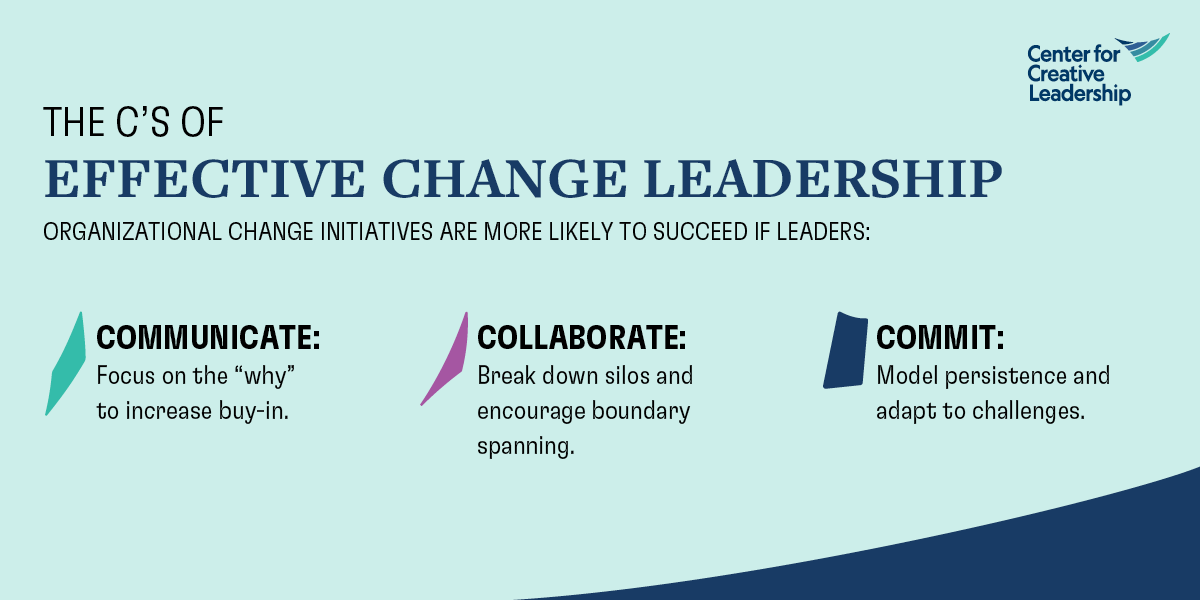9 Competencies for Effective Leadership Through Change
Leading change successfully is one of the biggest challenges of individual leaders and one of the most common problems that modern organizations face. In today’s world, the strategic imperative to change is often clear: Without being able to do things differently, your organization is unlikely to succeed, or even to last.
At its core, change management for leaders requires working together to create a shared understanding of change required to execute the strategy, and how to best make it happen. But change-management research has demonstrated time after time that organizational change initiatives fail more often than they succeed, despite all the resources put into creating change management processes.
We know that effective leadership is essential to successful change. But we wanted to understand the differences in change leadership between successful and unsuccessful change leaders, so our researchers conducted a study and asked 275 senior executives to reflect on successful and unsuccessful change efforts they’d led.
Our goal was to characterize “change-capable leadership,” define the key leadership competencies necessary for effective leadership through change, and better understand leadership behaviors that could contribute to change failures.
The executives we surveyed were all participants in our Leadership at the Peak program, which targets executives with more than 15 years of management experience, responsibility for 500 or more people, and decision-making authority as members of top management teams. All of them were seasoned leaders. Our researchers found that the most change-capable leaders have 9 shared competencies that ensure effective leadership though change.
Our study revealed 9 competencies for leadership and change management that can be further divided into 3 main categories:
- Core competencies that we call “the 3 C’s of change leadership:” communication, collaboration, and commitment;
- Competencies related to leading the process of change; and
- Competencies related to leading people through change.
Let’s look at each in turn, as together, these 9 competencies are key in how to lead change most effectively.
The 3 C’s of Change Leadership: Communicate, Collaborate, Commit
Our researchers found that 3 core skills provide the essential connection between the process part of change and the people part of change, which is why we call them the essential 3 C’s of change leadership.
Core Skills for Leading Change
1. Communicate.
Unsuccessful change leaders tended to focus on the “what” behind the change. Successful ones communicated both the “what” and the “why.” Change leaders who explained the purpose of the change, and connected it to the organization’s values or explained the benefits, created stronger buy-in and urgency for the change. (This is why we say purpose in leadership is so important.)
2. Collaborate.
Bringing people together to plan and execute change is critical. Successful change leaders collaborated across boundaries, encouraged employees to break out of their silos, and refused to tolerate unhealthy competition. They also included employees in decision-making early on, strengthening their commitment to change. Unsuccessful change leaders failed to engage employees early and often in the change process.
3. Commit.
Successful change leaders made sure their own beliefs and behaviors support the change, too. Change is difficult, but leaders who negotiated it successfully were resilient and persistent, and willing to step outside their comfort zone. They also devoted more of their own time to the change effort and focused on the big picture. Unsuccessful change leaders failed to adapt to challenges, expressed negativity, and were impatient with a lack of results.
Leading Through Change Requires Balancing Process & People
Skills for Leading the Process of Change
Strategic change doesn’t happen on its own. Managing change as a leader requires you guide the process from start to finish. Here are the 3 key competencies that are part of how to lead change in terms of change processes.
4. Initiate.
After understanding the need for change, effective change leaders begin by making the case for the change they seek. This can include evaluating the business context, understanding the purpose of the change, developing a clear vision and desired outcome, and identifying a common goal. Unsuccessful change leaders say they didn’t focus on these tasks enough to reach a common understanding of the goal.
5. Strategize.
Successful change leaders developed a strategy and a clear action plan, including priorities, timelines, tasks, structures, behaviors, and resources. They identified what would change, but also what would stay the same. Leaders who weren’t successful said they failed to listen enough to questions and concerns, and failed to define success from the beginning.
6. Execute.
Translating strategy into execution is one of the most important things leaders can do. In our study, successful change leaders focused on getting key people into key positions (or removing them, in some cases). They also broke big projects down into small wins to get early victories and build momentum. And they developed metrics and monitoring systems to measure progress. Unsuccessful change leaders sometimes began micromanaging, got mired in implementation details, and failed to consider the bigger picture.
Remember that, as organizations evolve over time, both stability and change must coexist — which is not a problem to solve, but rather a polarity to manage. To help your organization achieve its full potential, change leaders must acknowledge both simultaneously. When change leaders find the sweet spot of “both/and,” they can present the change effort in a way that others can embrace.
Access Our Webinar!
Watch our webinar, Leading Through Change, and learn how to become a more change-capable leader, effective in both change management and change leadership.
Skills for Leading People Through Change
While formal change processes might be well understood, too many change leaders overlook the all-important human side of change equation.
The most effective change leaders know that another key in how to lead change is devoting effort to engaging everyone involved in the change and remembering that people need time to adapt to change — no matter how fast-moving the change initiative — to combat change fatigue and encourage embracing change. And they exhibit these 3 crucial competencies of leading people through change:
7. Support.
Successful change projects were characterized by leaders removing barriers to employee success. These include personal barriers, such as wounded egos and a sense of loss, as well as professional barriers, such as the time and resources necessary to carry out a change plan. Leaders of unsuccessful change focused exclusively on results, so employees didn’t get the support they needed for the change.
8. Sway.
Influencing others is about gaining not just compliance, but also the commitment necessary to drive change. It’s also about mapping out the critical change agents and defining what “buy-in” looks like from each stakeholder that will lead to a successful outcome. Effective change leaders identified key stakeholders — including board members, C-suite executives, clients, and others — and communicated their vision of successful change to them. Unsuccessful leaders told us they were more likely to avoid certain stakeholders rather than try to influence them.
9. Learn.
Finally, successful change leaders never assumed they had all the answers. They asked lots of questions and gathered formal and informal feedback. After all, great leaders are great learners. The input and feedback allowed them to make continual adjustments during the change. In the case of unsuccessful changes, leaders didn’t ask as many questions or gather accurate information, which left them without the knowledge they needed to make appropriate adjustments along the way.
One Last Thing: Resilience Matters for Change Leadership, Too
Lastly, managers who are tasked with leadership through change should recognize that leading people through complex change is difficult, and that all change comes at a cumulative cost. Simply put, change can drain employees — and leaders, too.
That’s why successful change leadership also requires resilience. Resilience helps people handle change’s inherent pressure, uncertainty, and setbacks. Leaders need to build their own reserves in support of their mental and physical health, and can guide others to face change in healthy and sustainable ways by learning and sharing practices for resilient leadership. In the end, that’s one other thing that change leaders need to be able to stay the course and succeed.
Ready to Take the Next Step?
Build more effective change leaders at your organization by building your team’s collective capacity and understanding of how to lead change, both the people and process aspects. Explore our change leadership solutions.
















